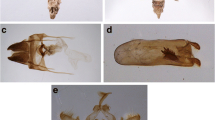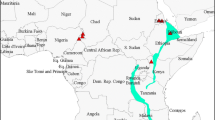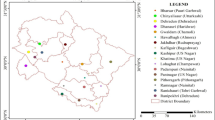Abstract
Habrobracon hebetor Say (Hymenoptera: Braconidae) is a cosmopolitan gregarious ectoparasitoid that attacks larvae of several species of Lepidoptera. Although there are two genetically different strains within H. hebetor, distribution of the strains has been poorly understood. In 2010, in Thailand, where H. hebetor has been known as a parasitoid of stored grain pests, it was found that H. hebetor attacked Opisina arenosella Walker (Lepidoptera: Oecophoridae), which is an invasive pest of coconut palm. For correct identification of this H. hebetor, we conducted DNA analysis and cross tests using populations collected from O. arenosella and stored grain pests in Thailand and populations in Japan known as H. hebetor. We obtained 413 bp of mitochondrial cytochrome oxidase I (COI) sequences and 414 bp of 16S rRNA gene sequences, and both indicated that there are two distinct clades within H. hebetor: one contains insects from Thailand, Spain, India, and Barbados; the other contains insects from Japan and the USA. There were no genetic differences or sexual isolation between Thai populations from different hosts. Our results also showed that populations in Thailand were sexually isolated from a H. hebetor population in Japan.



Similar content being viewed by others
References
Al-Maliky SK, Al-Izzi MAJ (1986) Parasites of Ectomyelois ceratoniae with biological studies on Apantales sp. group ultor in Iraq. Entomophaga 31:313–319
Bates D, Maechler M, Bolker B, Walker S (2015) Fitting linear mixed-effects models using lme4. J Stat Softw 67:1–48
Brower JH, Smith L, Vail PV, Flinn PW (1996) Biological control. In: Subramanyam B, Hagstrum DW (eds) Integrated management of insects in stored products. Marcel Dekker, New York, pp 223–286
Cook JM, Crozier RH (1995) Sex determination and population biology in the Hymenoptera. Trends Ecol Evol 10:281–286
Felsenstein J (1985) Confidence limits on phylogenies: an approach using the bootstrap. Evolution 39:783–791
Folmer O, Black M, Hoeh W, Lutz R, Vrigenhoek R (1994) DNA primers for amplification of mitochondrial cytochrome c oxidase subunit I from diverse metazoan invertebrates. Mol Mar Biol Biotechnol 3:294–299
Gahukar RT, Guevremont H, Bhatnagar VS, Doumbia YO, Ndoye M, Pierrard G (1986) A review of the pest status of the millet spike worm, Raghuva albipunctella De Joannis (Noctuidae: Lepidoptera) and its management in the Sahel. Insect Sci Appl 7:457–463
Gerling D (1971) Occurrence, abundance, and efficiency of some local parasitoids attacking Spodoptera littoralis (Lepidoptera: Noctuidae) in selected cotton fields in Israel. Ann Entomol Soc Am 64:492–499
Ghimire MN, Phillips TW (2010) Suitability of different lepidopteran host species for development of Bracon hebetor (Hymenoptera: Braconidae). Environ Entomol 39:449–458
Ghimire MN, Phillips TW (2014) Oviposition and reproductive performance of Habrobracon hebetor (Hymenoptera: Braconidae) on six different Pyralid host species. Ann Entomol Soc Am 107:809–817
Hebert PDN, Ratnasingham S, deWaard JR (2003) Barcoding animal life: cytochrome c oxidase subunit 1 divergences among closely related species. Proc R Soc Lond B 270:S96–S99
Heimpel GE, Antolin MF, Franqui RA, Strand MR (1997) Reproductive isolation and genetic variation between two “Strains” of Bracon hebetor (Hymenoptera: Braconidae). Biol Control 9:149–156
Hoelmer KA, Kirk AA (2005) Selecting arthropod biological control agents against arthropod pests: can the science be improved to decrease the risk of releasing ineffective agents? Biol Control 34:255–264
Holloway AK, Heimpel GE, Strand MR, Antolin MF (1999) Survival of diploid males in Bracon sp. near hebetor (Hymenoptera: Braconidae). Ann Entomol Soc Am 92:110–116
IPPC (2017) Coconut black headed caterpillar. https://www.ippc.int/en/countries/thailand/pestreports/2017/02/coconut-black-headed-caterpillar/. Accessed 1 Feb 2018
Khalil MS, Raza ABM, Afzal M, Aqueel MA, Khalil H, Hance T (2016) Effects of different host species on the life history of Bracon hebetor. Anim Biol 66:403–414
Kimura M (1980) A simple method for estimating evolutionary rate of base substitutions through comparative studies of nucleotide sequences. J Mol Evol 16:111–120
Konishi K, Narendran TC, Imamura T, Visarathanonth P (2004) Chalcididae (Hymenoptera) from rice stores in Thailand, with description of two new species. Entomol Sci 7:31–38
Loni A, Samartsev KG, Scaramozzino PL, Belokobylskij SA, Lucchi A (2016) Braconinae parasitoids (Hymenoptera, Braconidae) emerged from larvae of Lobesia botrana (Denis & Schiffermüller) (Lepidoptera, Tortricidae) feeding on Daphne gnidium L. ZooKeys 587:125–150
Mamedov AA (1989) Quantitative assessment of the efficiency of entomophages of Heliothis armigera Hb. (Lepidoptera: Noctuidae). Entomol Rev 68:1–12
Nasser M, Abdurahiman UC (2001) Biological control of the coconut caterpillar Opisina arenosella (Lepidoptera: Xylorictidae): achievements and prospects. In: Upadhyay RK, Mukerji KG, Chamola BP (eds) Biocontrol potential and its exploitation in sustainable agriculture. Kluwer Academic/Plenum Publishers, New York, pp 285–305
Papp J (2008) Redescriptions of Habrobracon concolorans (Marshall) and Habrobracon crassicornis (Thomson) (Hymenoptera: Braconidae: Braconinae). Entomologisk Tidskrift 129:165–172
Petters RM, Mettus RV (1980) Decreased diploid male viability in the parasitic wasp, Bracon hebetor. J Hered 71:353–356
Puttarudriah M, Basavanna GP (1956) A study on the identity of Bracon hebetor Say and Bracon brevicornis Wesmael (Hymenoptera: Braconidae). Bull Entomol Res 47:183–191
R Core Team (2017). R: a language and environment for statistical computing. R Foundation for Statistical Computing, Vienna, Austria. https://www.R-project.org/. Accessed 10 Jan 2018
Saadat D, Bandani AR, Dastranj M (2014) Comparison of the developmental time of Bracon hebetor (Hymenoptera: Braconidae) reared on five different lepidopteran host species and its relationship with digestive enzymes. Eur J Entomol 111:495–500
Saitou N, Nei M (1987) The neighbor-joining method: a new method for reconstructing phylogenetic trees. Mol Biol Evol 4:406–425
Sarfraz M, Keddie AB, Dosdall LM (2005) Biological control of the diamondback moth, Plutella xylostella: a review. Biocontrol Sci Technol 15:763–789
Tamura M (1994) Biology of Bracon hebetor Say (Hymenoptera: Braconidae). Kaoku-gaichu 16:41–46 (in Japanese with English summary)
Tamura K, Stecher G, Peterson D, Filipski A, Kumar S (2013) MEGA6: molecular evolutionary genetics analysis version 6.0. Mol Biol Evol 30:2725–2729
Thompson JD, Gibson TD, Plewniak F, Jeanmougin F, Higgins DG (1997) The CLUSTAL X windows interface: flexible strategies for multiple sequence alignment aided by quality analysis tool. Nucleic Acid Res 25:4876–4882
van Driesche RG, Hoddle MS (2000) Classical arthropod biological control: measuring success, step by step. In: Gurr G, Wratten S (eds) Biological control: measures of success. Springer Science and Business Media, Dordrecht, pp 39–75
Watanabe C (1933) On three species of Braconidae bred from some larvae of Pyralidae. Konchu 7:245–248 (in Japanese)
Whiting PW (1943) Multiple alleles in complementary sex determination of Habrobracon. Genetics 28:365–382
Youm O, Gilstrap FE (1993) Life-fertility tables of Bracon hebetor Say (Hymenoptera: Braconidae) reared on Heliocheilus albipuctella de Joannis (Lepidoptra: Noctuidae). Insect Sci Appl 14:455–459
Yu DSK, Achterberg C van, Horstmann K (2012) Taxapad, Ichneumonoidea 2011. http://www.taxapad.com/taxapadmain.php. Accessed Jan 2018
Acknowledgments
We thank Associate Prof. Dr. Anuchit Chinajariyawong and Prof. Dr. Kaoru Maeto for valuable comments on an earlier version of the manuscript. We thank Dr. Akihiro Miyanoshita for providing the Plodia interpunctella used in this study. This study was supported by the Research and Researchers for Industries (RRI), Ampol Food Processing, Ltd., and The Thailand Research Fund (TRF) (PHD56I0075 Code 56-106-0085).
Author information
Authors and Affiliations
Corresponding author
Rights and permissions
About this article
Cite this article
Chomphukhiao, N., Takano, Si., Takasu, K. et al. Existence of two strains of Habrobracon hebetor (Hymenoptera: Braconidae): a complex in Thailand and Japan. Appl Entomol Zool 53, 373–380 (2018). https://doi.org/10.1007/s13355-018-0568-6
Received:
Accepted:
Published:
Issue Date:
DOI: https://doi.org/10.1007/s13355-018-0568-6




